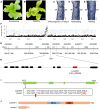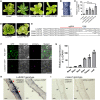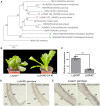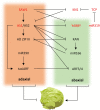Loss-of-function of SAWTOOTH 1 affects leaf dorsiventrality genes to promote leafy heads in lettuce
- PMID: 35916734
- PMCID: PMC9614500
- DOI: 10.1093/plcell/koac234
Loss-of-function of SAWTOOTH 1 affects leaf dorsiventrality genes to promote leafy heads in lettuce
Abstract
The mechanisms underlying leafy heads in vegetables are poorly understood. Here, we cloned a quantitative trait locus (QTL) controlling leafy heads in lettuce (Lactuca sativa). The QTL encodes a transcription factor, SAWTOOTH 1 (LsSAW1), which has a BEL1-like homeodomain and is a homolog of Arabidopsis thaliana. A 1-bp deletion in Lssaw1 contributes to the development of leafy heads. Laser-capture microdissection and RNA-sequencing showed that LsSAW1 regulates leaf dorsiventrality and loss-of-function of Lssaw1 downregulates the expression of many adaxial genes but upregulates abaxial genes. LsSAW1 binds to the promoter region of the adaxial gene ASYMMETRIC LEAVES 1 (LsAS1) to upregulate its expression. Overexpression of LsAS1 compromised the effects of Lssaw1 on heading. LsSAW1 also binds to the promoter region of the abaxial gene YABBY 1 (LsYAB1), but downregulates its expression. Overexpression of LsYAB1 led to bending leaves in LsSAW1 genotypes. LsSAW1 directly interacts with KNOTTED 1 (LsKN1), which is necessary for leafy heads in lettuce. RNA-seq data showed that LsSAW1 and LsKN1 exert antagonistic effects on the expression of thousands of genes. LsSAW1 compromises the ability of LsKN1 to repress LsAS1. Our results suggest that downregulation or loss-of-function of adaxial genes and upregulation of abaxial genes allow for the development of leafy heads.
© American Society of Plant Biologists 2022. All rights reserved. For permissions, please email: journals.permissions@oup.com.
Figures









Similar articles
-
The upregulated LsKN1 gene transforms pinnately to palmately lobed leaves through auxin, gibberellin, and leaf dorsiventrality pathways in lettuce.Plant Biotechnol J. 2022 Sep;20(9):1756-1769. doi: 10.1111/pbi.13861. Epub 2022 Jul 2. Plant Biotechnol J. 2022. PMID: 35634731 Free PMC article.
-
Upregulation of a KN1 homolog by transposon insertion promotes leafy head development in lettuce.Proc Natl Acad Sci U S A. 2020 Dec 29;117(52):33668-33678. doi: 10.1073/pnas.2019698117. Epub 2020 Dec 7. Proc Natl Acad Sci U S A. 2020. PMID: 33288708 Free PMC article.
-
Up-regulation of LsKN1 promotes cytokinin and suppresses gibberellin biosynthesis to generate wavy leaves in lettuce.J Exp Bot. 2022 Nov 2;73(19):6615-6629. doi: 10.1093/jxb/erac311. J Exp Bot. 2022. PMID: 35816166
-
The complex of ASYMMETRIC LEAVES (AS) proteins plays a central role in antagonistic interactions of genes for leaf polarity specification in Arabidopsis.Wiley Interdiscip Rev Dev Biol. 2015 Nov-Dec;4(6):655-71. doi: 10.1002/wdev.196. Epub 2015 Jun 24. Wiley Interdiscip Rev Dev Biol. 2015. PMID: 26108442 Free PMC article. Review.
-
Roles of ASYMMETRIC LEAVES2 (AS2) and Nucleolar Proteins in the Adaxial-Abaxial Polarity Specification at the Perinucleolar Region in Arabidopsis.Int J Mol Sci. 2020 Oct 3;21(19):7314. doi: 10.3390/ijms21197314. Int J Mol Sci. 2020. PMID: 33022996 Free PMC article. Review.
Cited by
-
Integration of crop modeling and sensing into molecular breeding for nutritional quality and stress tolerance.Theor Appl Genet. 2025 Aug 8;138(9):205. doi: 10.1007/s00122-025-04984-y. Theor Appl Genet. 2025. PMID: 40781147 Free PMC article. Review.
-
LsBLH2-LsOFP6-LsKANT3 module regulates bolting by orchestrating the gibberellin biosynthesis and metabolism in lettuce.Plant Biotechnol J. 2025 May;23(5):1668-1682. doi: 10.1111/pbi.14614. Epub 2025 Feb 11. Plant Biotechnol J. 2025. PMID: 39932895 Free PMC article.
-
Shaping leaves through TALE homeodomain transcription factors.J Exp Bot. 2024 Jun 7;75(11):3220-3232. doi: 10.1093/jxb/erae118. J Exp Bot. 2024. PMID: 38527334 Free PMC article. Review.
-
Cotton BLH1 and KNOX6 antagonistically modulate fiber elongation via regulation of linolenic acid biosynthesis.Plant Commun. 2024 Jul 8;5(7):100887. doi: 10.1016/j.xplc.2024.100887. Epub 2024 Mar 26. Plant Commun. 2024. PMID: 38532644 Free PMC article.
-
Lskipk Lsatpase double mutants are necessary and sufficient for the compact plant architecture of butterhead lettuce.Hortic Res. 2023 Dec 28;11(2):uhad280. doi: 10.1093/hr/uhad280. eCollection 2024 Feb. Hortic Res. 2023. PMID: 38371637 Free PMC article.
References
-
- Alconero R (1988) Lettuce (Lactuca sativa L.).In YPS Bajaj, eds, Crops II. Springer, Berlin, Heidelberg, pp 351–369
-
- Bhatt AM, Etchells JP, Canales C, Lagodienko A, Dickinson H (2004) VAAMANA—a BEL1-like homeodomain protein, interacts with KNOX proteins BP and STM and regulates inflorescence stem growth in Arabidopsis. Gene 328: 103–111 - PubMed
-
- Cheng F, Sun R, Hou X, Zheng H, Zhang F, Zhang Y, Liu B, Liang J, Zhuang M, Liu Y, et al. (2016) Subgenome parallel selection is associated with morphotype diversification and convergent crop domestication in Brassica rapa and Brassica oleracea. Nat Genet 48: 1218–1224 - PubMed
Publication types
MeSH terms
Substances
LinkOut - more resources
Full Text Sources

